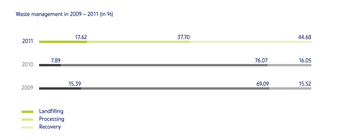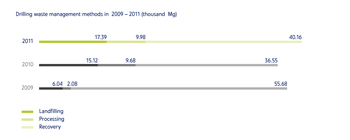Objective 4
To take into account environmental protection criteria when selecting new investment projects, solutions and technologies
In most cases, industrial activity does have an environmental impact. This is usually harmful to the environment; air pollution, water contamination, depletion of drinking water resources and reduced biodiversity are all examples of this impact. For centuries, especially in the industrial era, man exploited the environment to satisfy his needs. However, the emergence of the first material effects of this irrational management of natural resources has brought about a gradual change in attitudes.
The initiatives currently being undertaken on numerous levels share the single common purpose of eliminating or reducing the adverse effects of human activity. This is consistent with the sustainable growth principle, which provides for enough growth to meet the needs of today’s generation without depriving future generations of the ability to satisfy theirs. This principle also drives the PGNiG Group’s pro-environmental initiatives.
Initiatives/best practices
Waste
The waste management objective for PGNiG Group entities is to reuse waste or reduce its volume to the minimum.
All Group entities operating with Environment Management Systems in place have implemented effective waste management procedures. Following these procedures, the Group has managed to:
- Identify environmental impact related to waste, for example by determining areas where waste is generated and contamination may occur,
- Determine a method for minimising the volume of waste, primarily including waste sent to landfill sites (which is to be limited to unsorted municipal waste only).
The procedures set out the different waste handling processes to be used. Preference is given to waste recovery (limited only by the availability of processing technologies or, sometimes, by financial constraints). This is followed by pre-sorting, which results in waste that is ready for recycling. Waste processing that requires specific precautions or measures is conducted by specialist contractors holding the necessary licences (administrative approvals), selection of which is handled by the Group entities themselves.
Waste producers are all PGNiG Branches and Companies which hold the required permits and licences and comply with waste management requirements.
A total of 90.5 thousand Mg of waste was generated by the entire PGNiG Group in 2011, excluding municipal waste submitted for recovery, processing or landfilling.
The volume of waste generated in 2011 dropped by about 21% in comparison with the figure for 2010.
The chart presents methods of waste management across the Group in 2009–2011, except for drilling waste generated by Exploration Companies.
The total amount of waste generated annually by PGNiG Group entities depends primarily on the amount of drilling waste generated by the Exploration Companies. In 2011, drilling waste (the rock cuttings and drilling mud from oil and gas well drilling) accounted for approximately 71% of all waste generated by the PGNiG Group (including unsorted municipal waste) – 10% more than in 2010. Bits of rock are separated from drilling mud on vibrating screens or by other devices, such as desanders and desilters. Waste drilling mud is generated when circulation mud is exchanged for another kind (as required by the drilling technology), or when well drilling is completed and drilling fluid is no longer necessary. Drilling waste also includes process water mixed with drilling mud, cement slurry and other fluids from well treatments. The different drilling waste management methods used in 2009–2011 are shown in the table below.



